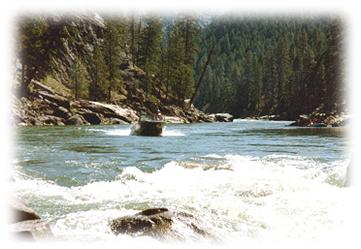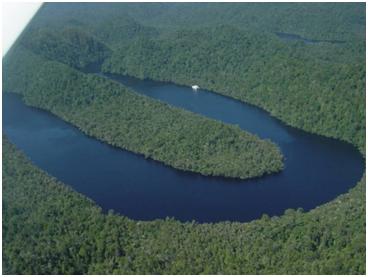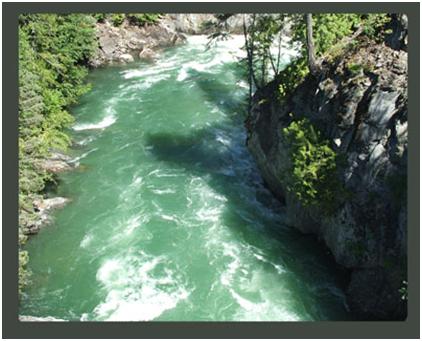This is the first in a new series of articles that IWP will host on various aspects of Environmental Flows. We welcome your comments and original articles for this series, please mail us at portal@arghyam.org
The other side of the story: Free-flowing rivers around the world
With around 5100 large dams, India ranks third in the world with regards to the number of large dams. The ongoing debate over the economic, social and environmental costs of large dams has indicated many times that these costs are not commensurate with their benefits. Although we have dammed all our major rivers, (except Brahmaputra and plans to dam its major tributaries are on way, some like Ranganadi have already been dammed), profoundly changing their hydrological, ecological, social and cultural systems, we are yet to form a policy which states that environmental flows in rivers are a necessity. It is more than clear now that environmental flows relate to well being of not only ‘birds and fishes’, but also of the entire human society . Take an example of fisheries, lack of flows in rivers and contractor-owned reservoir fishing has affected the livelihood of hundreds of thousands of small fishermen . Environmental flows also dilute pollution load, so let us not hide behind the fact that pollution is wiping out our riverine fish, not the absence of flows. It is also clear that environmental flows do NOT mean a decommissioning of all the present dams, nor do they mean any random figure like 60% or 10% of MAR . Eflows require reaching a wise compromise through science and local negotiations, for each river.
While many countries have put in place policies and laws for maintaining environmental flows in their rivers, there is also a rarer category: Rivers which have not been dammed yet, rivers which retain their connection from the source to the sea, nurturing myriad ecosystems and communities in their wake! These are known by many names like Free flowing rivers, Wild Rivers, Pristine/ Virgin rivers, Heritage Rivers, etc., each indicating their rare character and value. In ecological and cultural terms, the value of these rivers is immense and as more and more rivers are being dammed the world over, this value is increasing steeply. Unfortunately, in today’s economic terms, these rivers are still waiting to get their due recognition, but as human systems evolve, they will surely be seen as ‘invaluable’ service providers with phenomenal use and non use values.Such free flowing rivers are, as is evident, dwindling fast throughout. Of the 177 large rivers of the world only one third are free flowing and a mere 21 rivers, more than 1000 kilometers long retain a direct connection to the sea.
Ecologically, free flowing rivers have a huge significance. All natural flow levels have a specific ecological function, including drought level flows, which help in purging exotic species, as well in concentrating game at a smaller place, for the benefit of predators and flood flows, which help in numerous ways like groundwater recharge, nutrient balancing, fish spawning, sediment flushing, etc. Owing to the habitats they provide, the few free flowing/ least modified rivers in India are last refuges of endangered fish species like Giant Catfish, Gangetic Dolphin, Snow Trout, Mahaseer, etc. Free flowing stretches of river Chalakudy in Kerala, where water levels are not strongly affected by dams, support more than 50 fish species, while the National Chambal Gharial Sanctuary, Ken and Son National Parks support thriving populations of Gharials, Mugar and the Ganges River Dolphin. Despite being a Sanctuary, Chambal Gharial Sanctuary had to face turbulent times when a string of four hydropower projects were planned by Rajasthan in its course, affecting its unique biodiversity.
At the same time, free flowing rivers and stretches also provide innumerable community services like fisheries, tourism, water supply, to name a few. For example, one of the small free flowing rivers in the Western Ghats, Shastri, provides drinking quality water to its inhabitants throughout the year, without any dams. Estuary of River Anghanashini in Karnataka, provides income to more than 9600 household through bivalve collection alone. There is a very urgent need to assess the ecological goods and services provided by these rivers in order to have a fair cost-benefit analysis of dammed and undammed rivers.
Unfortunately, India does not have any legislation to protect the free flowing status of any of its rivers. In a recent attempt, following Dr. G.D. Agarwal’s fast unto death, a stretch of Bhagirathi had been declared to be free of dams. But, works on Loharinag Pala are again being considered and at the time of this writing, Dr. Agarwal at the age of 79 is on a fast-unto-death to save a small stretch of India’s so-called National River, again). Considering the very special cultural value of rivers like Ganga and Narmada in the hearts of all Indians, these steps are totally superficial.
Amidst this scenario, there are many countries which are actively trying to protect these last sentinels from the onslaught of dams and have been devising some ingenious legislative tools to co manage ecology, economy and societal well being.
So let us, for a change, look at the other side of the story, where policies and voluntary efforts are being made to enable rivers to run free.
There are a number of lessons to be learnt from these cases. Firstly: these policies and laws were not easily constituted. Many Individuals, Civil Society Organisations, Cultural Groups, Nature Groups, Indigenous People’s groups, etc., lobbied for them hard and long, and are still doing it. Secondly, these policies are not a mere compromise to keep some groups happy, so that the process of damming other rivers can go on without ‘disturbance’. Most of the countries have set criteria for identifying their own Wild and Scenic/ Heritage/Wild or National Rivers and have meticulously classified activities that can take place in various stretches of these rivers. Community participation and special attention to indigenous community and traditional water rights are also highlights of these cases.
Let us take a brief look at some of these efforts:
1. Wild and Scenic Rivers Act ( 1968) : United States
“It is hereby declared to be the policy of the United States that certain selected rivers of the Nation which, with their immediate environments, possess outstandingly remarkable scenic, recreational, geologic, fish and wildlife, historic, cultural or other similar values, shall be preserved in free-flowing condition, and that they and their immediate environments shall be protected for the benefit and enjoyment of present and future generations.”
The Act specifically “[d]eclares that the established national policy of dam and other construction at appropriate sections of the rivers of the United States needs to be complemented by a policy that would preserve other selected rivers or sections thereof in their free-flowing condition to protect the water quality of such rivers and to fulfill other vital national conservation purposes.”(emphasis added)
The essence of the Act, is protection of free-flowing character of the river. Free-flowing is defined in the Act as “existing or flowing in natural condition without impoundment, diversion, straightening, rip-rapping, or other modification of the waterway”. Note that, like it is contested in India that run –of-the- river schemes do not affect a river, according to this Act, a free flowing river does not include modification in the waterway or straightening.To qualify, a river or river segment must be in a free-flowing condition and must be deemed to have one or more “outstandingly remarkable” scenic, recreational, geologic, fish and wildlife, historic, cultural or other similar values.
Based on their characters, Rivers are classifies are Wild, Scenic and Recreational, with varying management in each of the categories. This mechanism allows development of varying degree to palces on and along the river.
The Act prohibits federal support for actions such as the construction of dams or other in stream activities that would harm the river's free-flowing condition, water quality, or outstanding resource values.
On the March 30, 2010, the congress added 1,100 miles of rivers to this Act. Currently, the number of rivers protected under the Wild and Scenic Rivers scheme to a total of 252 (American Rivers 2009).
Salmon River, one of the longest Wild and Scenic Rivers in Idaho,running 425 miles
Image Courtesy: National Wild & Scenic Rivers
2. Canadian Heritage Rivers System (CHRS) 1984
“Canada’s outstanding rivers will be nationally recognized and managed through the support and stewardship of local people and provincial, territorial and federal governments to ensure the long-term conservation of the rivers’ natural, cultural and recreational values and integrity.”
Vision of Canadian Heritage River System Charter, 1997
The Canadian Heritage Rivers System (CHRS) is Canada's national river conservation program. The CHRS was established in 1984 by the federal, provincial and territorial governments to conserve and protect the best examples of Canada’s river heritage to give them national recognition, and to encourage the public to enjoy and appreciate them (http://www.chrs.ca/About_e.htm). It is a cooperative program of the governments of Canada, all 10 provinces, and the three territories. CHRS is a Public Trust and participation in the CHRS is purely voluntary.
The system is governed by a Heritage Rivers Board which has members from the government as well as citizens. For a river to be included in the Heritage system, it needs to be nominated and designated. To be considered, the river must have outstanding natural, cultural and/or recreational values, a high level of public support, and the application should demonstrate that sufficient measures will be put in place to ensure that those values will be maintained. One of the important (though not the deciding) criteria related to ‘Natural Integrity’ is ‘absence of human made impoundments in the river course’.
Fraser Canyon, Fraser River
Image Courtesy: Canadian Heritage Rivers System
In a recent happening, MP of North Alberta voiced strong opposition to an oilsands project, which was about to draw freshwater from the untouched Clearwater River, using the support from his constituents through Clearwater’s CHRS status. This is far cry from our country where rivers which are untouched and of great ecological and cultural importance are looked upon as untapped resources, as if we are deriving no service from them currently.
Interesting part is that CHRS does not only work with free flowing rivers, but also on highly developed rivers like Grand and Ottawa, to conserve their heritage characters. Currently, 38 rivers are designated as Heritage Rivers, while six are nominated. These rivers represent Canada’s diverse social, cultural and ecosystems.
3. Wild Rivers Act, Australia
According to the Act, a Wild River is defined as “a channel, channel network, or a connected network of waterbodies, of natural origin and exhibiting overland flow (which can be perennial, intermittent or episodic) in which:
- the biological, hydrological and geomorphological processes associated with river flow; and
- the biological, hydrological and geomorphological processes in those parts of the catchment with which the river is intimately linked,
have not been significantly altered since European settlement.
Like India, many of Australia’s river systems received a ravaging during the process of colonisation and the development of modern Australia. Most of its river systems today are severely degraded due to over-extraction, pollution, catchment modification and river regulation (Dunn 2000, Arthington and Pussey 2003, Kingsford et al 2005). 
Gordon River, Tasmania
Image Courtesy: World Heritage Cruises
Wild River Criteria:
Wild Rivers is defined as a stream that has all, or almost all, of its natural values intact. This does not necessarily mean that the river is in pristine condition, but rather that it remains largely unaffected by development in its catchment area. The Department of Environment and Resource Management has identified the following elements that are necessary to constitute a wild river:
Like in India, water is a State subject in Australia and each state has the right to manage its Wild Rivers in whichever way it deems fit.
How the Legislation works:
In order to give more definition for this assessment process, a declared Wild River Area (defined by a river basin) is spatially mapped into different management areas, which have varying rules to guide development activities in the Wild Rivers Code.
The management areas include:
- High Preservation Area: the buffer zone around the main watercourses and wetlands where ecologically destructive development like dams, irrigated agriculture and strip mining is prohibited. Lower-impact activities, such as grazing, infrastructure such as houses, and fishing are allowed.
- Preservation Area: the remainder of the basin, where most development activity can occur as long as it meets requirements that minimise the impacts on the river system.
- Floodplain Management Area: important floodplain areas in the basin (shown in cross-hatch above), where the construction of levees and other flow-impeding development is regulated to protect the connectivity between this area and the main river channels.
- Subartesian Management Area: areas where there is an underlying aquifer that is strongly connected to the river system. Water extraction from this area needs to be considered in the overall water allocation for the basin.
- Designated Urban Area: areas where there is a town or village, so certain types of development are exempt from the Wild Rivers Code (shown in pink in the above map).
- Nominated Waterways: secondary tributaries or streams in the Preservation Area where certain development set-backs apply.
In practice this means that destructive developments like large dams, intensive irrigation, and mining cannot occur in sensitive riverine and wetland environments (in the High Preservation Area), while a range of other developments have to meet sensible requirements outlined by the Wild Rivers Code.
4. National Rivers, Sweden
River Torne, One of the National Rivers of Sweden
Image Courtesy: Europe a la Carte
Conclusion:
Looking at the immense use and non use values of free flowing rivers, the need to protect these (few) rivers is very real and urgent. Without getting entangled in trying to exactly define a free flowing river ( as most of the rivers, if not the feeder streams, have been impounded through small scale structures, which impound a miniscule quantity of water, compared to large dams), we can assume that rivers whose water flow and sediment flow is not strongly affected by dams, which have not been embanked or channelized, which have good riparian health and water quality and which support important biodiversity and community services should be protected for the benefit of current and future generations. These rivers will provide an engaging outdoor laboratory for young minds of tomorrow, who may not see a natural river at all. Like river Gundia in Western Ghats, which is now threatened with hydropower dams, these rivers will provide the last haven for dwindling aquatic, riparian and avian biodiversity and may nurture a thriving forest ecosystem.
Looking at the ecological assessment of rivers in India, we can safely conclude that ecological goods and services of most of the rivers are not yet quantified, and it will be indeed be an irreparable loss to lose these services through short sighted management decisions.
At the same time, even in the case of dammed rivers, there are stretches which are of unique ecological/ social/ cultural value, which should be protected. For example, stretches of rivers like Chalakudy, Jia Bhoroli, Ramganga, Kabini, etc. which support immensely rich fisheries as well as avian biodiversity, Stretches of rivers like Narmada, Ganga, Krishna, Godavari which are of high cultural/ spiritual importance . These stretches should receive special protection through measures like Ecological Sensitive Areas, National Parks, Conservation areas, etc.
At the very least, rivers representing each ecological class like Himalayan, desert rivers, peninsular rivers from eastern and Western Ghats, etc., need to be conserved and ecologically/socially important stretches in all the large rivers should be identified and protected.
All in all, looking at the dismal performance of Pollution Control Boards, Fisheries Departments, Action Plans like Ganga and Yamuna Action Plans which result in NO change in the status of river, it is high time that we learn our lesson:
Conservation is better than restoration.
References:
- Dyson, M., Bergkamp, G., Scanlon, J. (eds). Flow. The Essentials of Environmental Flows. IUCN, Gland, Switzerland and Cambridge, UK. xiv + 118 pp.
- Personal communication with Chairman of National Association of Fishermen,
- Sandhu, J. S. & Toor, H. S. 1984. Effects of Dams and Fishways on Fish Fauna with Special Reference to
- Punjab, in Status of Wildlife in Punjab. Indian Ecological Society, Ludhiana, India. pp 117-124
- D. Jackson et al, The Influence of Dams on River Fisheries, Submission to the World Commission on Dams
- Smakhtin, V.; Anputhas, M. 2006. An assessment of environmental flow requirements of Indian river basins. Colombo, Sri Lanka: International Water Management Institute. 42p. (IWMI Research Report 107)
This article was later published in the World Rivers Review, June 2011 issue.
